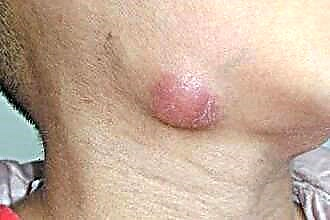Nasal polyps are called teardrop-shaped or round growths of the mucous membrane. These are benign and painless formations, but, nevertheless, they bring a lot of trouble - they cause nasal congestion, provoke headaches, etc. Many have heard that it is possible to get rid of polyps only by surgery, but this is not entirely true. We will tell you what medicine for nasal polyps effectively reduces polyps, and even helps prevent the appearance of new polyps.
In particular, with polypous rhinosinusitis (this is the name of this condition in medicine), topical glucocorticosteroids - hormonal nasal drops can be prescribed. How do these drugs work? Are they always effective? Read on for more details.
Symptoms of polyposis rhinosinusitis
An unpleasant feature of polypous rhinosinusitis is the absence of vivid symptoms of the disease in the early stages of development.
Indeed, small polyps disturb the state of health to an insignificant extent. Mild discomfort that occurs with polyps in the nose (congestion, runny nose, poor sleep), the patient often attributes to other reasons, for example - a cold, fatigue. However, over the years, the size and number of polyposis growths increase, and the patient notices more and more symptoms.
 Common symptoms of polyposis rhinitis are:
Common symptoms of polyposis rhinitis are:
- persistent progressive nasal congestion;
- dullness of smell, and then taste sensations;
- almost constant runny nose (mucus can be clear or purulent, yellowish);
- frequent headaches caused by lack of oxygen and chronic inflammation;
- possible pain in the maxillary sinuses;
- snore;
- nasal voice.
In the later stages of polypous rhinosinusitis, the risk of developing infectious diseases of the nasopharynx and paranasal sinuses significantly increases. That is why it is so important to start treating polyps as early as possible.
Causes
The exact reasons for the appearance of polyposis formations have not been established, but it is known that the risk of their appearance increases significantly with:
- chronic infectious diseases of the nasopharynx and paranasal sinuses;
- respiratory allergies (hay fever);
- bronchial asthma;
- violation of the structure of the nose, the presence of cysts or curvature of the septum;
- metabolic disorders of salicylic and arachidonic acids;
- intolerance to non-hormonal anti-inflammatory drugs (such as analgin, aspirin, etc.).
Treatment
Treatment of polyposis rhinosinusitis includes conservative and surgical approaches. Most often, combined treatment is recommended, including both surgical removal of polyps and taking medications.
It is recommended to treat polyps in the nose exclusively with medicinal means only in the early stages of the development of the disease.
Unfortunately, most patients postpone the visit to the otolaryngologist until the last, and seek medical help only with severe disturbance of nasal breathing, when the polyps are already very large. It is very difficult to achieve significant improvement with medication alone when the disease is already advanced. Surgical removal of polyposis growths is recommended.
In any case, the question of the preferred method of treatment is decided by the attending physician. We will tell you about the advantages and disadvantages of the existing methods.
Drug therapy
Drug therapy for polyposis rhinosinusitis may include:
- A short course of oral corticosteroid drugs (hormonal and anti-inflammatory tablets). Medicines based on fluticasone, flunisolide mometasone, triamcinolone, etc. may be prescribed.
- Topical glucocorticosteroids (hormonal drops for nasal polyps). Such drops (or spray) may contain budesonide, fluticasone, mometasone and triamcinolone - hormonal substances that reduce inflammation of the mucous membrane. When such drops are instilled, glucocorticosteroids are practically not absorbed into the bloodstream, so the likelihood of side effects is extremely small. The course of treatment with drops can vary from 1 to 12 weeks.
- Taking antihistamines. These are drugs that are widely used for allergies - Suprastin, Claritin, Erius, Loratadin and others. They block histamine, a mediator of inflammation, thus reducing swelling, nasal irritation and mucus production.
- A course of antibiotics if a secondary infection of the paranasal sinuses or nasal cavity develops against the background of polypous rhinosinusitis.
- The course of immunomodulators is prescribed in case of chronic diseases of the nasopharynx.
One of the most effective drugs for polypous rhinosinusitis is nasal drops from Nasonex polyps. Nasonex contains mometasone as an active ingredient. It has a strong anti-inflammatory effect. As a result, it reduces the sensitivity of the mucous membrane to irritants (allergens and other irritating chemicals).
Studies devoted to the study of the effect of Nasonex in rhinosinusitis polyposis have shown a significant improvement in the well-being of patients, in particular, a decrease in nasal congestion and restoration of the sense of smell. An endoscopic examination of the study participants showed that the size of the polyps decreased, and signs of mucosal inflammation disappeared.
Contraindications to the use of Nasonex:
 Chronic or acute nasopharyngeal infection. In this case, you must first cure the infection with antibiotics, and only after the end of the course of antibiotic therapy, start taking Nasonex.
Chronic or acute nasopharyngeal infection. In this case, you must first cure the infection with antibiotics, and only after the end of the course of antibiotic therapy, start taking Nasonex.- The presence of wounds in the nose. The fact is that glucocorticosteroids can inhibit the healing process, therefore, after surgery or nasal injuries, it is necessary to wait for complete healing.
- Age up to 18 years (hormonal nasal preparations are recommended only for adults).
- Hormonal disorders (in particular, disruption of the adrenal glands).
During pregnancy during lactation, Nasonex is prescribed with caution.
A drug that has a similar effect is Tafen Nasal spray. This product contains the glucocorticosteroid budesonide. Like Nasonex, Tafen spray can be used continuously for up to 3 months.
During treatment, it is recommended to completely exclude the use of non-hormonal anti-inflammatory drugs, reduce contact with allergens (dust, wool, mold, etc.), and also refuse food containing salicylates.
Operation
If polyposis growths in the nose are multiple and large, treatment with corticosteroids will be of little benefit, even if the course of treatment is increased to the maximum. It is much wiser in this case to resort to surgical removal of the formations.
The indications for surgery are as follows:
- inability to breathe through the nose;
- the presence of purulent discharge;
- chronic inflammation of the paranasal sinuses (sinusitis);
- snoring, nasal voice.
There are several ways to carry out the operation:
- Polypectomy is the excision of polyps with a scalpel under local or general anesthesia. The scalpel is inserted through the nostrils. The disadvantages of the method are poor accuracy (the result depends entirely on the qualifications of the surgeon), as well as the lack of access to the sinuses.
- Loop removal. One of the oldest techniques. The polyp is captured by the loop and literally ripped off the surface of the mucous membrane. At this time, the method is considered outdated, since the loop removes not only polypous growth, but also part of the healthy mucosa. In addition, severe bleeding is possible with this type of surgery.
- Laser destruction. This operation is very popular due to its speed (10-15 minutes) and bloodlessness. However, the method also has disadvantages. First, laser destruction cannot be used to remove multiple polyps. Secondly, the laser beam is unable to penetrate the sinuses.
- Endoscopic removal is the most effective and accurate method available today. During the operation, the surgeon uses an endoscope - a device with which it is possible to examine the inner surface of the nasal cavity and sinuses. Polyps are removed with a shaver - a very precise and sharp device. At the same time, the normal mucous membrane is preserved as much as possible. Indications for endoscopic removal are the presence of multiple polyposis growths. It is usually performed under general anesthesia.

In the postoperative period, the nasal cavity requires special care. Clots of mucus and crusts that form on the mucous membrane must be removed by treating with antiseptic solutions. The first couple of days after the operation, the doctor does it, and then, within 7-10 days, you need to do it yourself. To cleanse the nasal cavity at home, drip a saline solution (saline solution, or special solutions such as Salin, Aqua Maris) into the nostrils, and then gently blot your nose with a napkin. Touching wounds with cotton swabs, fingers, etc. it does not follow.
In addition, people who have undergone surgery to remove polyps should be attentive to the health of the nasal cavity - avoid allergens and infectious agents, do not overcool, limit the use of salicylates and non-hormonal anti-inflammatory drugs.
After surgical removal of the polyp, the doctor usually prescribes medication to prevent the formation of new growths. For this, all the same intranasal glucocorticosteroids are used.
Conclusion
Which method of dealing with polyposis rhinosinusitis is more effective - medical or surgical? Comparing these two approaches is not easy, because their effect is absolutely different.
So, surgery is a quick elimination of the end result of a pathological process, which does not affect the pathogenesis of the disease itself. In this sense, surgical removal is symptomatic treatment. Indeed, after the operation, the patient's well-being quickly improves, but there are no guarantees that polypous growths will not form again. Sad statistics - in more than half of cases, after surgical removal of polyps, the disease recurs.
Drug treatment, on the contrary, affects the pathogenesis of the disease, preventing the formation of new growths. However, in relation to already formed large polyps, medications are ineffective.
That is why the treatment of polyposis rhinosinusitis should be comprehensive: drug preparation for surgery, surgical removal, and a prophylactic course of glucocorticosteroids.

 Chronic or acute nasopharyngeal infection. In this case, you must first cure the infection with antibiotics, and only after the end of the course of antibiotic therapy, start taking Nasonex.
Chronic or acute nasopharyngeal infection. In this case, you must first cure the infection with antibiotics, and only after the end of the course of antibiotic therapy, start taking Nasonex.


